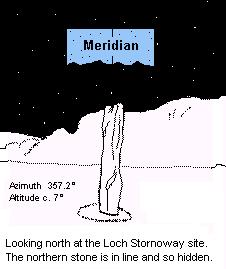
Loch Stornoway, Knapdale
Stones
of Wonder
QUICK LINKS ...
HOME PAGE
INTRODUCTION
WATCHING
THE SUN, MOON AND STARS
THE
MONUMENTS
THE
PEOPLE AND THE SKY
BACKGROUND
ARCHAEOASTRONOMY
USING
THE SITE DESCRIPTION PAGES
VISITING
THE SITES
THE
LEY LINE MYSTERY
THE
SITES
ARGYLL
AND ARRAN
MID
AND SOUTH SCOTLAND
NORTH
AND NORTH-EAST SCOTLAND
WESTERN
ISLES AND MULL
Data
DATES
OF EQUINOXES AND SOLSTICES, 1997 to 2030 AD
DATES
OF MIDSUMMER AND MIDWINTER FULL MOONS, 1997 to 2030 AD
POSTSCRIPT
Individual
Site References
Bibliography
Links
to other relevant pages
Contact
me at : rpollock456@gmail.com
Standing Stones NR743616*
How to find: Follow the A83 south from Tarbert for 1km, then take the minor road on the right (signposted for Kilberry). After 1km go left on the B8024. Travel for 13km and look out for the stones in the field to the left (south).
Best time of year to visit: Noon or any clear night.
There are two stones in alignment here on a north-south line, set in a flat field close to the sea. The stones are 3 metres and 2.3 metres high, and stand over two metres apart. About one hundred metres to the west in another field is a third standing stone, also 2.3 metres tall.
 The
single stone appears to have no astronomical significance ; as seen
from between the two aligned stones the azimuth of 283.7° and
horizon height of 3.3° produces a declination of +10.4°,
so the line points to nothing in particular.
The
single stone appears to have no astronomical significance ; as seen
from between the two aligned stones the azimuth of 283.7° and
horizon height of 3.3° produces a declination of +10.4°,
so the line points to nothing in particular.
The two aligned stones are set north to south, on a bearing of 357.2° and 177.2°. This is very close to an accurate meridian. In both directions the line is of course beyond the setting or rising points of the sun or moon. The meridian is not an arbitrary modern convention, but a fact of nature caused by the rotation of the planet Earth on its axis ; in our northern latitudes this causes the heavens to appear to revolve around one point in the north, and causes the sun and moon always to take up their highest positions in the sky due south.
The northern horizon is high enough so that stars would always be fully visible. The meridian may have been identified by observing the circling of the stars around the celestial pole (north), or by observing the shortest shadow cast by the stones about noon (south). These phenomena are of course linked, but the real significance of the meridian to the prehistoric inhabitants of Knapdale is not known.
